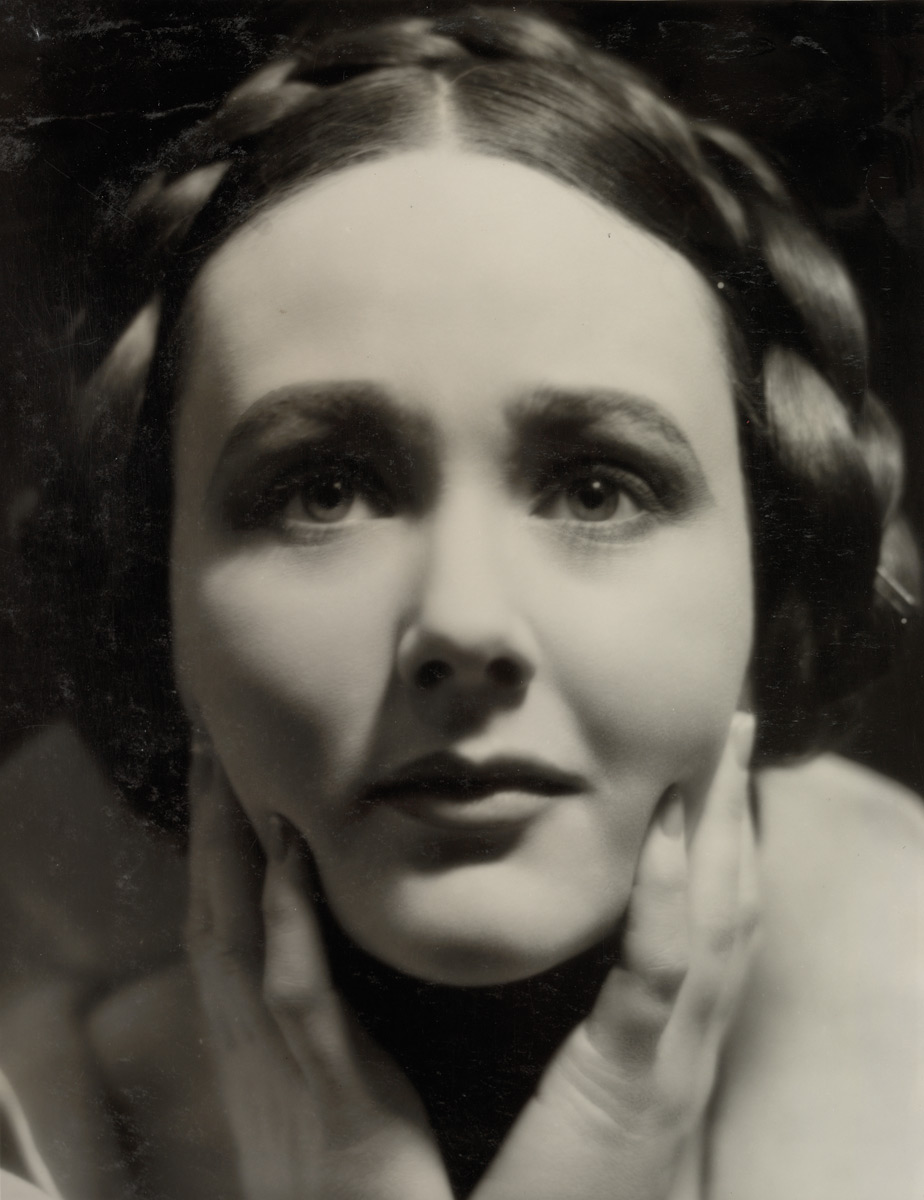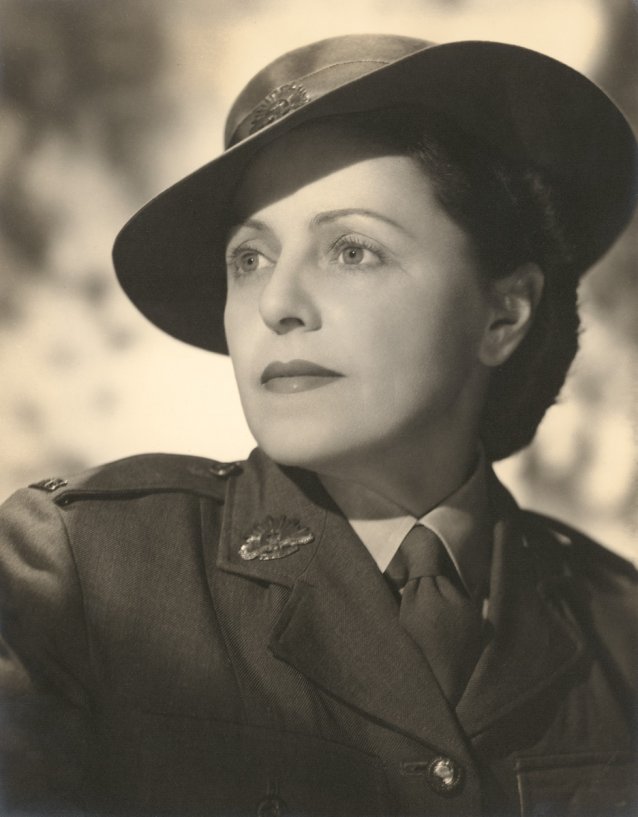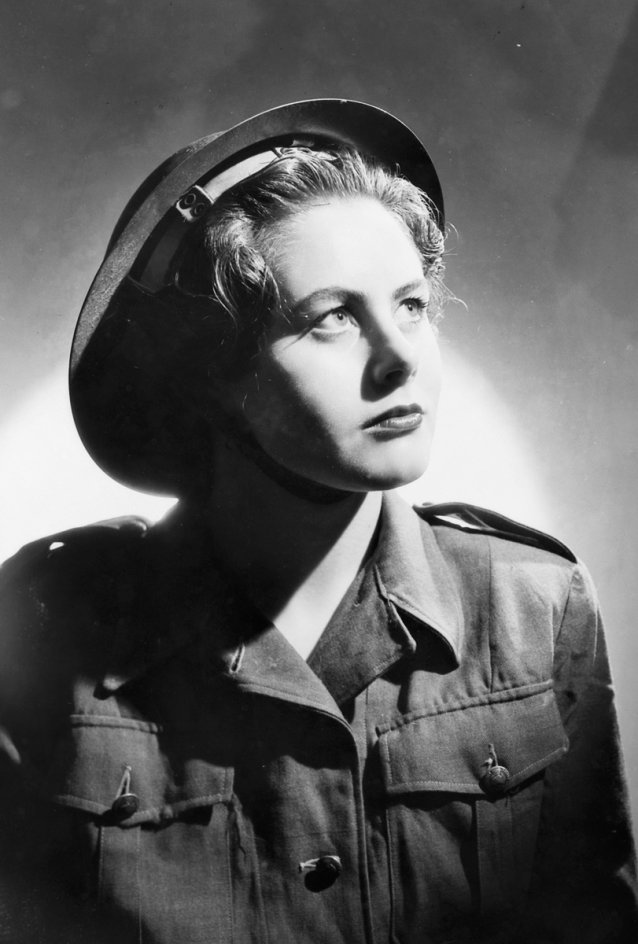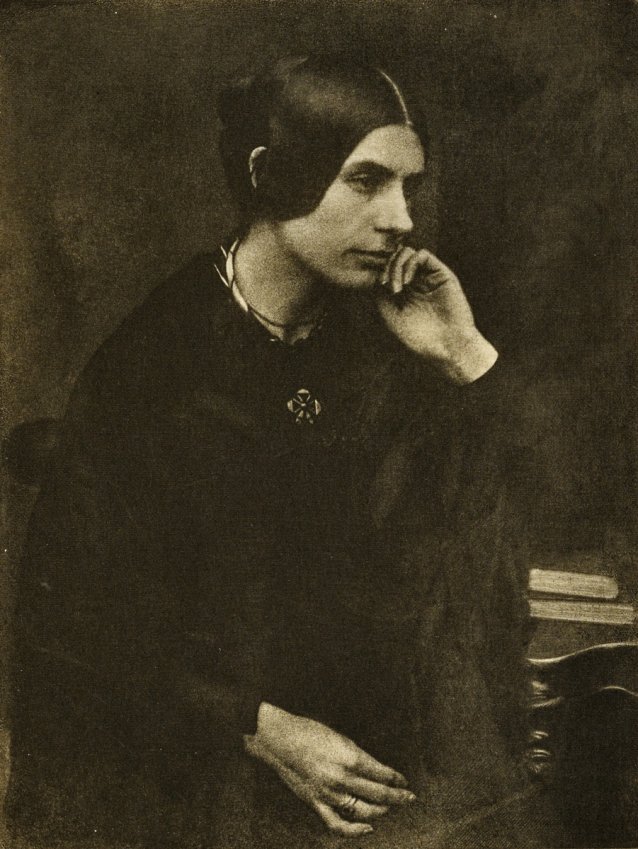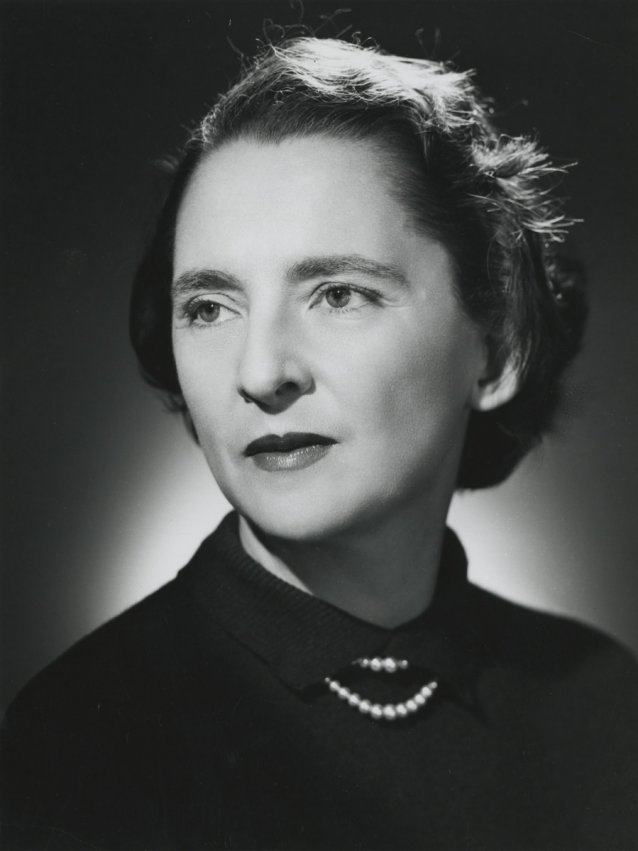Concealed behind the grand Victorian facades and musty olde-worlde charm of 1930s Collins Street, Melbourne, there was a burgeoning modernity set to emerge which would challenge societal strictures, including the re-casting of rigid gender norms. A troubled decade, punctuated for the most part by the hardships associated with the First World War and subsequent Depression, the thirties gave rise to this new, modernist dynamic, and, with it, visions of a promising future. Women in particular were buoyed by the renewed vitality that characterised the period, finding new freedoms, privileges and rights beyond those previously afforded them. As beacons of hope and strength, and symbols of empowerment, those women who chose to forge paths in male-dominated fields also posed a threat to existing conventions of the era. With these changes afoot, the portrait photography of Athol Shmith acted as an aesthetic vanguard throughout the Second World War period, contributing to Australian women’s sense of identity by presenting images of the physical and stylistic ideal of the modern new woman.
Progressive pictures
by Aimee Board, 25 July 2017
While the bourgeoisie were ‘doing the Block’ – seeing and being seen in Melbourne’s famous arcades – towards the upper, Paris end of Collins Street, there was another apparition that warranted attention. It was the year 1939 when a young Louis ‘Athol’ Shmith, (1914-1990), opened his photographic studio in the Rue de la Paix building, number 125 on the southern side of Collins Street. The building, originally intended for cosmetics entrepreneur Helena Rubinstein, was in close proximity to other prominent photographers of the day, Arthur Dickinson, Jack Cato and Spencer Shier. And a plush setting it was, with its blue furniture and carpet a shade of deep pink, the luxury setting perhaps an alluring one for fashion doyenne Lillian Wightman of Le Louvre, just across the way. Projecting style and charisma in his tailored suit with Windsor knot, Shmith’s presence on upper Collins was befitting of the faux-Parisian élan. Indeed, Shmith’s arrival in the heart of the exclusive area was timely, for the blossoming of the ‘New Woman’ with her ‘New Look’ was beginning to materialise.
At the time he relocated his studio from St Kilda to Collins Street (at a mere twenty-five years of age), the precocious Shmith had already achieved excellence, both in Australia and abroad. Elected fellow of the Royal Society of Arts, London, in 1935, and fellow of the Royal Photographic Society in 1939, he was a regular entrant and judge in the Salon exhibitions of the period. Shmith’s fashion illustrations and wedding photography for Melbourne’s elite had also earned him plaudits and contributed to his burgeoning reputation.
It was only weeks after opening his doors, however, that the outbreak of the Second World War brought a halt to Shmith’s studio operations. His attempt at enlistment thwarted due to failing his medical examinations, he assisted the army with vital photographic analyses, including decoding details related to the American landing in Italy. Shmith also joined the growing number of photographers contributing to the nation’s historical documentation of the war – as a photographer on the home front, he took portrait photographs of hundreds of servicewomen and men. In an interview in 1989 with Isobel Crombie, then Curator of Photography at the National Gallery of Victoria, he said, ‘Every soldier going to war was having his picture taken, and when the Americans came here they swamped the studio’.
In contrast, there was a notable absence of portraits of servicewomen throughout the First World War period. Serving in traditionally female occupations, Australian women filled positions as nurses and in other medical roles for the Australian Army Nursing Service, and as volunteer fundraisers and teachers for the Red Cross. Most married women were expected to stay at home in a caretaker role.
Following the Great War, several feminist associations emerged in Australia. In 1929 the emergence of the United Associations of Women, one of the more radical feminist groups of the early-mid 20th century, assisted greatly in challenging society’s staunchly conservative views. Led by President, Jessie Street, (1889-1970), and her committed group of feminists, the women campaigned vigorously to achieve gender equality, with one aim being to secure economic independence for married women.
Operating under the motto ‘For freedom and equality of status and opportunity’, the women continued their cause throughout the 1930s and into the 1940s, playing a key role in organising The Australian Women’s Charter Conference in 1943, a gathering which focused on the question of how women’s interests would be advanced in the post-war reconstruction period. The conference resulted in the landmark feminist manifesto, The Australian Women’s Charter. Written by women, the document outlined reforms for women in the post-war world, including securing real equality of status, opportunity and liberties for both men and women. Subsequently, women were presented with new opportunities across various fields throughout the Second World War period. In the case of photography there were unprecedented developments, with women (for the first time) appointed alongside their male counterparts in a range of capacities, from darkroom assistants and technicians though to professional photographers. The increased number of both male and female photographers covering the home front resulted in the emergence of many new photographic styles, with an accompanying range of meanings and associations.
A memento of a loved one, for instance, was vastly different from a portrait commissioned by the Government to entice capable young debutantes from well-to-do backgrounds to enlist. Shmith’s portrait of Sergeant Marjorie Alice Weynton, (1922-2015) provides an interesting example. Weynton was the wife of Lieutenant Alexander Gordon Weynton, (1905-1966), a signaller in the 8th Division who was captured and became a prisoner of war in 1942. The personally commissioned portrait of Marjorie was likely a keepsake for her husband to carry with him during his military service. It’s evident in this image that Shmith is attuned not only to the character of each of his sitters but also to the function and meaning of his portraits. By photographing Weynton with her eyes cast towards the distant horizon, the photographer not only suggests her heroic qualities but also conveys a sense of her strength and hope. The fact that Shmith’s portrait reveals a certain truth of character is assisted by the image’s insistent realism; while it may use diffused mid-tones and dappled light, and be Pictorialist in manner, it nevertheless retains a lucid, contemplative quality.
By contrast, one of Sydney’s prominent commercial photographers of the day, John Lee, (b. 1907), known for his highly theatrical poses and the dramatic lighting of his subjects, was influenced by the Hollywood lighting techniques he’d become accustomed to using in his commercial work. As the first commercial photographer commissioned directly by the Australian War Memorial, Lee was afforded more creative freedom than other photographers, such as Edward Cranstone, (1903-1989), who, as head of the Department of Information’s Military History section, produced robust images of capable women at the helm for promotional purposes – they appeared in popular magazines such as the Women’s Weekly. Cranstone’s compositions, characterised by strong diagonal lines and upward camera angles, conveyed the heroism of the military spirit, on display here in an image from the ‘Women in Uniform’ series of photographs. These pictures, for the Civil Construction Corps, were deployed in a recruitment campaign for the Australian Women’s Army. Such images shared a likeness with propaganda photographs across Europe and America throughout the period.
In John Lee’s photograph of Gunner NF Dempsey, the photographer has employed strong back lighting and key light from above to create the glamorised look typically used in the portraiture of stars from stage and screen. With fewer mid-tones than Shmith, the harshness of Lee’s artificial illumination creates almost a flattening of form. Indeed, in some respects the portrait feels staged, with a consequent stasis of character.
Shmith, like Lee, adopted the glowing halo effect to emphasise the gaze of his subjects, though he did so in a manner more nuanced. Shmith understood the function of such lighting, its non-realistic effect serving to promulgate an ideology of women’s objectification – the attraction of the gaze, the object of male worship. Shmith chose, rather, to light his portraits of servicewomen in a more conservative manner, one that owed much to the Pictorialist aesthetic of the late 19th and early 20th centuries. In doing so, Shmith portrayed the essence of his female characters as strong and dignified. The gestural positioning of Shmith’s sitter’s hands may also give us clues as to the social status or psychological state of the subject. We can gain a subtle insight into the qualities of the character, be it an emphasis on grace, loss, strength or hope.
It is instructive here to consider the work of Scottish painter and member of the Royal Scottish Academy of Arts, David Octavius Hill, (1802-1870). Considered the first Pictorialist and master of the camera, Hill introduced an artistic quality to his portraits. His photograph Lady in Black demonstrates the care he took with the compositional arrangement of his subjects; it affords a dignity to his subject, and offers insight into the sitter’s character, perhaps suggesting the warmth of the relationship between subject and photographer.
Similarly, Shmith’s photograph of sculptor and painter, Lorraine Fraser, (b. 1927), sister of former Australian Prime Minister Malcolm, affords the sitter an understated dignity. We see the angular drape of the arms complimented by the flowing lines of the chair, and the shadows moving rhythmically to meet the sitter’s powerful gaze. Softly backlit, the tonal values in Fraser’s hair extend the image’s range. German photographer and photo historian, Helmut Gernsheim, (1913-1995), noted David Hill’s ‘completeness of modelling’, noting that it enabled him to adopt an originality of style. He further added that Hill ‘proved himself to be one of the most masterly interpreters of the head and hands the world has ever seen’. Shmith’s modelling of figurative elements and tonal values are also masterly; the image of Fraser has an almost painterly quality, reminiscent of a Rembrandt painting. With her centred poise, she emits an understated confidence.
As publicity photographer for the ABC in Melbourne for over thirty years, Shmith had access to many local and international stars of stage and screen, providing him with endless inspiration for his portraits. His love of music and passion for playing the vibraphone as a young boy, as well as his aspirations to one day be a conductor, would always translate into somewhat deeper relationships with his musical subjects.
Australian heroine Nancy Weir (1915-2008), piano virtuoso from age thirteen, was described as having ‘the best musical ear since Mozart’. At the outbreak of the Second World War, Weir’s career was put on hold while she became a ‘musical spy’. Her tales of performing for troops before parachuting into Rome were a far cry from an episode of her younger days, when, at fourteen years of age, she was chased by adoring fans up the Collins Street hill after performing Beethoven’s Piano Concerto No. 3 with the Melbourne Symphony Orchestra. As Weir left the Town Hall, ‘the crowd surged around her as she stood on the steps … Hundreds of enthusiasts surrounded the car and impeded its progress more than half way up Collins Street hill’, as one newspaper journalist recalled.
In Shmith’s photograph of Weir, it is her almost fragile sensitivity and strength of mind that emanate. Fluent in German, Weir’s artistic intelligence and innate musicality were well known, but it is her beautifully shaped face and calm gaze that are illuminated in Shmith’s portrait. His subtle three-point lighting creates a dignified look, the fill-lighting overhead providing a point of ‘saintly’ ascent.
Photographs of aspiring actors and actresses could propel a little known figure to stardom, as was the case with South Yarra-born actress Miss Kathleen Rhys-Jones, (b. 1914), otherwise known as Margot Rhys. Shmith’s portrait of Rhys – who played the lead role of Jane Judd in Charles Chauvel’s 1935 colonial film, Heritage – presents her as an emblem of strength and hope. Shmith’s promotional photography for Heritage was widely distributed, with the very same portrait of Margot Rhys appearing on the packaging for ‘Mercolized Wax’ facial cream. Miss Rhys recommended Mercolized Wax and Dearborn Face Powder as ‘the perfect complexion beautifier … They are delightful, and your complexion will be really vastly improved by the use of these true beautifiers’. Shmith’s portrait of Rhys is lit with a top spotlight diffused by tracing paper to create an ‘inky-dinky’ effect – one of Shmith’s noted techniques in creating a flawless appearance. There is also an emphasis on the classical lines of the figure, reminiscent of the purist beauty found in ancient Grecian sculpture. Shmith’s ability to set his subjects at ease is evident in his portraits of Margot. Her gaze is aimed directly at the camera; a quiet confidence, a result of her newfound fame, radiates out towards the photographer. She becomes an emblem of strength and vitality for the emerging modern woman.
Athol Shmith’s portraits of women throughout the inter-war and Second World War era conveyed messages of hope, strength, dignity and power. From servicewomen to musical virtuosos, artists and actresses, women were portrayed as beacons of strength and figureheads of self-empowerment, breaking free from the confines of conventional late Victorian and Edwardian society. In doing so, their courage, and that of the early 20th century feminists, in liberating themselves from the limitations of domesticity, was seen as a threat to the patriarchal, long-held expectations of women. The new and brave modern woman had emerged.
This article has been written as part of a major collaboration between the National Portrait Gallery and National Film and Sound Archive, supported by the National Collecting Institutions Touring and Outreach Program.
Related people
Related information
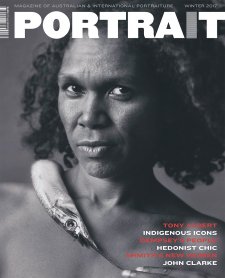
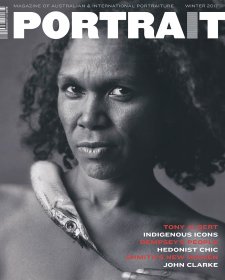

Portrait 57, Winter 2017
Magazine
The discovery of Dempsey's People, Australian rugby greats, Athol Shmith's progressive pictures, and powerful Indigenous portraits.



Humour’s warm refuge
Magazine article by Angus Trumble
Angus Trumble pays tribute to John Clarke.



Full time
Magazine article by Alistair McGhie
Alistair McGhie reminisces about three Australian rugby greats commissioned for the Portrait Gallery collection by Patrick Corrigan AM.
